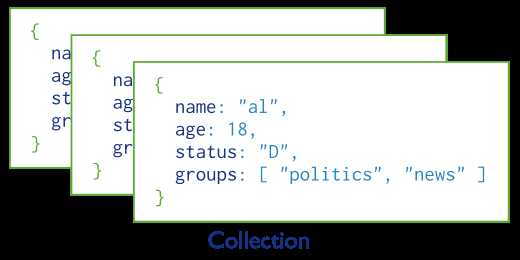标签:when ... tar explicit imu one database following bsp
MongoDB stores BSON documents, i.e. data records, in collections; the collections in databases.

In MongoDB, databases hold collections of documents.
To select a database to use, in the mongo shell, issue the use <db> statement, as in the following example:
use myDB
If a database does not exist, MongoDB creates the database when you first store data for that database. As such, you can switch to a non-existent database and perform the following operation in the mongo shell:
> use myNewDB
switched to db myNewDB
> db.myNewCollection1.insert( { x: 1 } )
...
WriteResult({ "nInserted" : 1 })
The insert() operation creates both the database myNewDB and the collection myNewCollection1 if they do not already exist.
For a list of restrictions on database names, see Naming Restrictions.
MongoDB stores documents in collections. Collections are analogous to tables in relational databases.
If a collection does not exist, MongoDB creates the collection when you first store data for that collection.
> db.myNewCollection2.insert( { x: 1 } )
WriteResult({ "nInserted" : 1 })
> db.myNewCollection3.createIndex( { y: 1 } )
2016-11-30T11:29:16.665+0800 I INDEX [conn6] build index on: myNewDB.myNewCollection3 properties: { v: 1, key: { y: 1.0 }, name: "y_1", ns: "myNewDB.myNewCollection3" }
2016-11-30T11:29:16.665+0800 I INDEX [conn6] building index using bulk method
2016-11-30T11:29:16.667+0800 I INDEX [conn6] build index done. scanned 0 total records. 0 secs
{
"createdCollectionAutomatically" : true,
"numIndexesBefore" : 1,
"numIndexesAfter" : 2,
"ok" : 1
}
>
Both the insert() and the createIndex() operations create their respective collection if they do not already exist.
For a list of restrictions on collection names, see Naming Restrictions.
MongoDB provides the db.createCollection() method to explicitly create a collection with various options, such as setting the maximum size or the documentation validation rules. If you are not specifying these options, you do not need to explicitly create the collection since MongoDB creates new collections when you first store data for the collections.
To modify these collection options, see collMod.
New in version 3.2.
By default, a collection does not require its documents to have the same schema; i.e. the documents in a single collection do not need to have the same set of fields and the data type for a field can differ across documents within a collection.
Starting in MongoDB 3.2, however, you can enforce document validation rules for a collection during update and insert operations. See Document Validation for details.
To change the structure of the documents in a collection, such as add new fields, remove existing fields, or change the field values to a new type, update the documents to the new structure.
MongoDB - Introduction to MongoDB, Databases and Collections
标签:when ... tar explicit imu one database following bsp
原文地址:http://www.cnblogs.com/huey/p/6117328.html